Token reinforcement: a review and analysis
- PMID: 19794838
- PMCID: PMC2648534
- DOI: 10.1901/jeab.2009.91-257
Token reinforcement: a review and analysis
Abstract
Token reinforcement procedures and concepts are reviewed and discussed in relation to general principles of behavior. The paper is divided into four main parts. Part I reviews and discusses previous research on token systems in relation to common behavioral functions--reinforcement, temporal organization, antecedent stimulus functions, and aversive control--emphasizing both the continuities with other contingencies and the distinctive features of token systems. Part II describes the role of token procedures in the symmetrical law of effect, the view that reinforcers (gains) and punishers (losses) can be measured in conceptually analogous terms. Part III considers the utility of token reinforcement procedures in cross-species analysis of behavior more generally, showing how token procedures can be used to bridge the methodological gulf separating research with humans from that with other animals. Part IV discusses the relevance of token systems to the field of behavioral economics. Token systems have the potential to significantly advance research and theory in behavioral economics, permitting both a more refined analysis of the costs and benefits underlying standard economic models, and a common currency more akin to human monetary systems. Some implications for applied research and for broader theoretical integration across disciplines will also be considered.
Keywords: behavioral economics; conditioned reinforcement; cross-species analysis; symmetrical law of effect; token reinforcement.
Figures
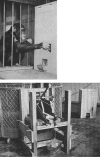


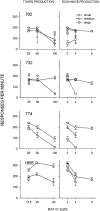
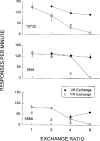

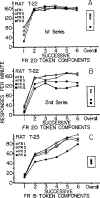


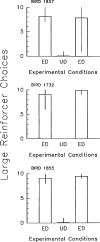
Similar articles
-
Token reinforcement: Translational research and application.J Appl Behav Anal. 2018 Apr;51(2):393-435. doi: 10.1002/jaba.439. Epub 2018 Feb 21. J Appl Behav Anal. 2018. PMID: 29468686 Review.
-
Pigeons' demand and preference for specific and generalized conditioned reinforcers in a token economy.J Exp Anal Behav. 2015 Nov;104(3):296-314. doi: 10.1002/jeab.181. J Exp Anal Behav. 2015. PMID: 26676183
-
The several roles of stimuli in token reinforcement.J Exp Anal Behav. 2015 Mar;103(2):269-87. doi: 10.1002/jeab.117. Epub 2015 Jan 20. J Exp Anal Behav. 2015. PMID: 25604188
-
Assessing the value of token reinforcement for individuals with autism.J Appl Behav Anal. 2015 Summer;48(2):448-53. doi: 10.1002/jaba.207. Epub 2015 Apr 30. J Appl Behav Anal. 2015. PMID: 25930718
-
The token economy for schizophrenia: review of the literature and recommendations for future research.Schizophr Res. 2005 Jun 15;75(2-3):405-16. doi: 10.1016/j.schres.2004.08.026. Schizophr Res. 2005. PMID: 15885531 Review.
Cited by
-
Reward and punishment act as distinct factors in guiding behavior.Cognition. 2015 Jun;139:154-67. doi: 10.1016/j.cognition.2015.03.005. Epub 2015 Mar 28. Cognition. 2015. PMID: 25824862 Free PMC article.
-
Pigeons' choices with token stimuli in concurrent variable-interval schedules.J Exp Anal Behav. 2013 Mar;99(2):159-78. doi: 10.1002/jeab.12. Epub 2013 Jan 2. J Exp Anal Behav. 2013. PMID: 23460072 Free PMC article.
-
TerraKids: An Interactive Web Site Where Kids Learn about Saving the Environment.Behav Anal. 2010 Fall;33(2):193-6. doi: 10.1007/BF03392218. Behav Anal. 2010. PMID: 22532714 Free PMC article. No abstract available.
-
A Comprehensive Systematic Review of Procedures and Analyses Used in Basic and Preclinical Studies of Resurgence, 1970-2020.Perspect Behav Sci. 2022 Nov 21;46(1):137-184. doi: 10.1007/s40614-022-00361-y. eCollection 2023 Mar. Perspect Behav Sci. 2022. PMID: 37006602 Free PMC article. Review.
-
Treatment of Substance Use Disorders With a Mobile Phone App Within Rural Collaborative Care Management (Senyo Health): Protocol for a Mixed Methods Randomized Controlled Trial.JMIR Res Protoc. 2025 Mar 26;14:e65693. doi: 10.2196/65693. JMIR Res Protoc. 2025. PMID: 40138685 Free PMC article.
References
-
- Autor S.M. The strength of conditioned reinforcers as a function of frequency and probability of reinforcement. In: Hendry D.P, editor. Conditioned reinforcement. Homewood, IL: Dorsey Press; 1969. pp. 127–162.
-
- Ayllon T, Azrin N.H. The token economy: A motivational system for therapy and rehabilitation. New York: Appleton-Century-Crofts; 1968.
-
- Battalio R.C, Kagel J.H, Winkler R.C, Fisher E.B, Jr, Bassman R.L, Krasner L. An experimental investigation of consumer behavior in a controlled environment. Journal of Consumer Research. 1974;1:52–60.
-
- Bickel W.K, DeGrandpre R.J, Higgins S.T. The behavioral economics of concurrent drug reinforcers: A review and reanalysis of drug self-administration research. Psychopharmacology. 1995;118:250–259. - PubMed
Publication types
MeSH terms
LinkOut - more resources
Full Text Sources

